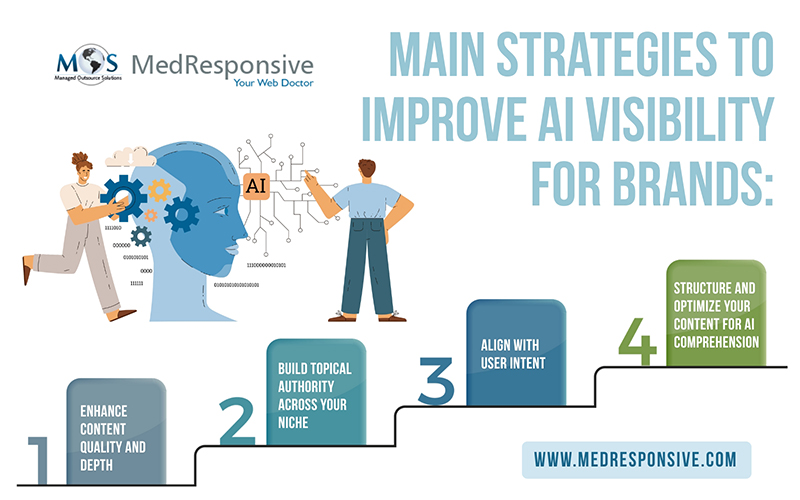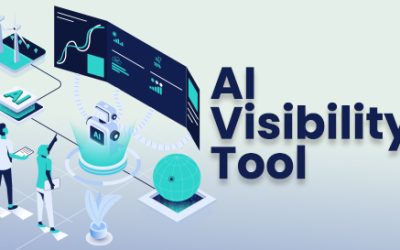For years, we navigated the web by clicking blue links that carried us from page to page. Ranking on the first page meant the difference between visibility and obscurity, shaping which businesses thrived and which fell behind. This battle for securing the top-ranking spot turned search engine optimization into a billion-dollar industry, where visibility was built through keywords, backlinks, and content.
However, the path to being found has changed, as online visibility is no longer dominated by search alone. With the rise of LLMs, generative AI has become a new discovery portal for users, providing synthesized answers directly instead of ranked lists. This has introduced a new ecosystem where AI visibility determines which brands and content reaches users first. Companies that are yet to implement AI visibility optimization strategy can utilize affordable digital marketing services to remain visible, relevant, and competitive in an AI-first era of information discovery.
What Is AI Visibility?
Today’s users increasingly rely on AI-powered recommendation engines, search engines, and AI-driven interfaces such as ChatGPT, Copilot, and Gemini to seek information. Unlike SERP pages, which point users to a list of links, AI-driven platforms interpret intent, summarize information, provide recommendations, and generate voice responses to user queries.
In this rising dynamic environment, traditional SEO tactics like keyword optimization and backlink building alone aren’t enough. Instead, brands and creators need to focus on how their content is understood, mentioned, cited, recommended, or generated by AI-driven responses. Large language model visibility is less about competing for a position on a page and more about shaping how AI perceives, ranks, and presents your content to users.
Companies that adapt to this new landscape will have their content surfaced more often, recommended more widely, and trusted more readily by AI-driven tools. For brands that want to stay relevant and maintain visibility in this AI dominant era, optimizing for generative engine optimization (GEO) is as critical as traditional SEO tactics. Just as SEO once required understanding search engines’ ranking signals, AI visibility demands understanding generative models’ priorities:
- Content Quality and Comprehensiveness
- Topical Authority
- User Intent Alignment
- Brand Citations, Quotes, and Mentions
- Content Structure, Format, and Clarity
- Information Relevance and Accuracy
As AI becomes the default way people find information, websites that optimize for GEO along with their conventional SEO strategies are poised for increased brand visibility, build better reputation, and drive high-intent, qualified traffic.
Top AI Visibility Strategies for Digital Marketers
No matter how search shifts, conventional SEO strategies remain the foundation, however, they are no longer sufficient on their own. This is why improving AI visibility isn’t about abandoning traditional SEO but rather integrating GEO strategies with a deeper understanding of AI behavior. Let’s explore the key actionable steps that brands can take to boost website visibility in AI-generated summaries:
- Enhance Content Quality and Depth
Large language models (LLMs) pull and present information based on freshness, clarity, usefulness, and quality of the content. Content creators should prioritize crafting well-researched, comprehensive materials to increase the chance of being surfaced in AI summaries. Here are some tips to develop AI-friendly content:
- Create content that provides in-depth, comprehensive answers on your chosen topic. For example, if you are writing about healthcare marketing, don’t just define it. Instead, discuss strategies, explain challenges, and provide real-world examples in an objective, unbiased tone.
- Incorporate latest proprietary data, original case studies, expert quotes, and unique statistics into your content to provide fresh perspective, set your content apart from competitors, and become an indispensable resource for AI systems.
- Human experts can leverage AI-powered content tools to enhance research, keyword discovery, and content optimization. For instance, leverage AI for analyzing trending topics, identifying semantic keyword clusters, and detecting content gaps. This hybrid intelligence can help to refine readability, build a meticulous verification system, and ensure factual accuracy, accelerating the overall content creation process.
- Regularly revisit and update old, outdated content to increase your chances of appearing in answers for evergreen topics. Refresh older posts with new research findings, timely statistics, and relevant examples so the material stays accurate and aligned with current trends.
By matching your content to the way AI models parse, synthesize, and respond to user prompts, you can ensure it remains relevant as user reliance on generative AI increases.
- Build Topical Authority across Your Niche
AI systems tend to prefer content with strong authority, expertise and credibility when referencing answers. Companies should develop thought leadership pieces with distinctive brand identity, showcasing deep understanding of their industry. For example, instead of summarizing emerging trends, brands can analyze challenges, provide expert actionable commentary, and present unique insights from your experience. Incorporating original research, expert interviews, or proprietary data not only sets your content apart but also signals to AI that your brand is a reliable source.
Here are some tips to establish brand authority in your domain:
- Publish consistently around core themes to reinforce your niche expertise. Repeatedly addressing related topics allows AI models to recognize your brand as a go-to authority in that area, increasing the likelihood your content is surfaced in summaries or recommendations.
- Demonstrate your website’s E-E-A-T signals by including expert author credentials, quotes from subject matter experts, and mentions from authoritative external sources. Brand representatives can post expert pieces on LinkedIn, engage in online community discussions, and contribute to industry publications to strengthen topical authority.
- Develop signature insights or proprietary frameworks unique to your brand. Establishing a distinctive methodology, perspective, or recurring series of analysis can differentiate your content from generic sources, making it more likely to be referenced or surfaced by AI-driven tools.
- LLMs rely on signals such as third-party citations, reviews, and feedback to evaluate a brand’s credibility and authority. Leverage social proof and industry recognition such as awards, certificates, notable mentions, and high-quality reviews to promote your content and build strong brand reputation.
A trusted online presence can help to earn recognition and value from LLMs, increasing the likelihood your website is recommended when people seek information in your domain.
- User Intent Alignment
AI systems and chat bots are built to find relevant information and help users make decisions, which is why LLMs prioritize content that directly satisfies user intent. Understanding the underlying purpose behind a query, whether it’s transactional, informational, navigational, or commercial, allows brands to create high-intent content that answers the user’s needs. Here are actionable steps to align your content with user intent:
- AI systems process content using principles aligned with semantic SEO, so use natural speech patterns, colloquial phrases, and preferred language that mirrors user preferences to improve your odds of appearing in AI-generated responses.
- Map content to specific query types by identifying whether your audience is seeking a how-to guide, comparative analysis, product guides, or expert recommendations. Tailoring your content format to the query type increases the chance AI systems will surface it as a relevant answer.
- Continuously monitor performance from both AI tools and users with key engagement metrics that go beyond standard analytics such as citation frequency, AI-attributed conversions, and Share of Voice (SOV) in AI.
- Repurpose your best long-form content into multiple formats such as short-form formats — video clips, infographics, and FAQs. This allows AI models to surface and reference your insights across multiple discovery channels.
By understanding intent and delivering content that anticipates user needs, brands can position their content as the most contextually relevant answer, supporting higher visibility within the generative AI ecosystem.
- Structure and Optimize Your Content for AI Comprehension
Even the most insightful content can be overlooked if AI systems struggle to parse it. Large language models rely on clear organization, logical hierarchy, and well-defined signals to interpret and surface information accurately. Structuring your material for machine readability makes it easier for AI to extract key points and present them to users. Here are actionable ways to refine content structure for AI:
- Use clear headings and subheadings to break topics into logical sections with descriptive H2/H3 tags so AI can quickly map the relationship between ideas and identify relevant segments for summaries.
- Targeting long-tail keywords and semantic phrases that reflect actual user questions helps LLMs match your content to nuanced search intent and surface it in context-rich responses. Use the inverted pyramid style to provide direct, concise answers first, and then follow it up with detailed explanations, supporting examples, and expert opinions for deeper understanding.
- Implement schema markup and structured data by adding elements such as FAQ schema, product details, or article metadata. This improves AI’s ability to parse and categorize information because it provides explicit cues about content’s context and purpose.
- Optimize technical SEO for AI bots with files such as robots.txt, llms.txt, and an up-to-date XML sitemap to guide crawlers and improve indexability.
- A technically optimized site is essential to ensure your content is crawled, understood, and ranked, as intelligent systems prefer sites that are fast and easy to access across devices. Maintain a robust technical architecture by prioritizing fast load times, mobile responsiveness, and clean internal linking hierarchy to improve both user experience and machine comprehension.
By combining clear structure with strong technical foundations, site owners can ensure both users and AI navigate your content effortlessly, boosting visibility in generative search results.
With the right generative engine optimization strategy, brands can shift AI’s disruption of organic traffic into an opportunity for greater visibility. Brands that prioritize AI-first digital marketing strategy can partner with providers outsourcing digital marketing services to dominate the next era of search.





